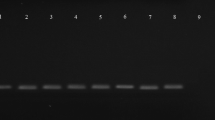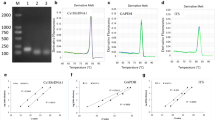Abstract
Cylindrocarpon species are known to be a component of the pathogen/pest complex that incites apple replant disease. In South Africa, no information is available on apple associated Cylindrocarpon species and their pathogenicity. Therefore, these aspects were investigated. Among the isolates recovered from apple roots in South Africa, four species (C. destructans, C. liriodendri, C. macrodidymum and C. pauciseptatum) were identified using β-tubulin gene sequencing and phylogenetic analysis. This is the first report of C. liriodendri, C. macrodidymum and C. pauciseptatum on apple trees. Cylindrocarpon macrodidymum was the most prevalent. Isolates within each of the four species were pathogenic towards apple seedlings, but varied in their virulence. With a single exception, all isolates were able to induce lesion development on seedling roots. Only 57% of the isolates, which represented all four species, were able to cause a significant reduction in seedling weight and/or height. The greatest seedling growth reductions were caused by two isolates of C. destructans, and one isolate each of C. liriodendri and C. macrodidymum. A quantitative real-time polymerase chain reaction (qPCR) method was developed for simultaneous detection of all four Cylindrocarpon species. qPCR analyses of Cylindrocarpon from the roots of inoculated seedlings showed that the amount of Cylindrocarpon DNA in roots was not correlated to seedling growth reductions (weight and height) or root rot. The qPCR method is, however, very useful for the rapid identification of apple associated Cylindrocarpon species in roots. The technique may also hold potential for being indicative of Cylindrocarpon disease potential if rhizosphere soil rather than roots are used.




Similar content being viewed by others
References
Alaniz, S., Armengol, J., Leόn, M., García-Jiménez, J., & Abad-Campos, P. (2009). Analysis of genetic and virulence diversity of Cylindrocarpon liriodendri and C. macrodidymum associated with black foot disease of grapevine. Mycological Research, 113, 16–23.
Barbetti, M. J. (2005). Cylindrocarpon didymum – a root pathogen of subterranean clover in the lower south-west of Western Australia. Australasian Plant Pathology, 34, 111–114.
Booth, C. D. (1966). The genus Cylindrocarpon. Mycological Papers (CMI), 104, 1–56.
Braun, P. G. (1991). The combination of Cylindrocarpon lucidum and Pythium irregulare as a possible cause of apple replant disease in Nova Scotia. Canadian Journal of Plant Pathology, 13, 291–297.
Braun, P. G. (1995). Effects of Cylindrocarpon and Pythium species on apple seedlings and potential role in apple replant disease. Canadian Journal of Plant Pathology, 17, 336–341.
Brayford, D. (1993). Cylindrocarpon. In L. L. Singleton, J. D. Mihail, & C. M. Rush (Eds.), Methods for research on soilborne phytopathogenic fungi (pp. 103–106). St. Paul: American Phytopathologic Society Press.
Carstens, E., Van Niekerk, J. M., Smit, W. A., & Fourie, P. H. (2010). Resolving the status of Neonectria ditissima in South Africa. Australasian Plant Pathology, 39, 43–45.
Dubrovsky, S., & Fabritius, A. (2007). Occurrence of Cylindrocarpon spp. in nursery grapevines in California. Phytopathologia Mediterranea, 46, 84–86.
Dullahide, S. R., Stirling, G. R., Nikulin, A., & Stirling, A. M. (1994). The role of nematodes, fungi, bacteria, and abiotic factors in the etiology of apple replant problems in the Granite Belt of Queensland. Australian Journal of Experimental Agriculture, 34, 1177–1182.
Gilliam, C. H., Watson, M. E., & Sheppard, W. J. (1982). Fertilization of cotoneaster in a pine bark medium. Scientia Horticulturae, 18, 185–190.
Glass, G. V., Peckham, P. D., & Sanders, J. R. (1972). Consequences of failure to meet assumptions underlying the fixed effects analyses of variance and covariance. Review of Educational Research, 42, 237–288.
Halleen, F., Schroers, H.-J., Groenewald, J. Z., & Crous, P. W. (2004). Novel species of Cylindrocarpon (Neonectria) and Campylocarpon gen. nov. associated with black foot disease of grapevines (Vitis spp.). Studies in Mycology, 50, 431–455.
Halleen, F., Schroers, H. J., Groenewald, J. Z., Rego, C., Oliveira, H., & Crous, P. W. (2006). Neonectria liriodendri sp. nov., the main causal agent of black foot disease of grapevine. Studies in Mycology, 55, 227–234.
Hamelin, R. C., Bérubé, P., Gignac, M., & Bourassa, M. (1996). Identification of root rot fungi in nursery seedling by nested multiplex PCR. Applied Environmental Microbiology, 62, 4026–4031.
Harrison, C. J., & Langdale, J. A. (2006). A step by step guide to phylogeny reconstruction. The Plant Journal, 45, 561–572.
Jaffee, B. A., Abawi, G. S., & Mai, W. F. (1982). Fungi associated with roots of apple seedlings grown in soil from an apple replant site. Plant Disease, 66, 942–944.
John, J. A., & Quenouille, M. H. (1977). Experiments: Design and analysis. England: Charles Griffin & Co Ltd.
Katoh, K., & Toh, H. (2008). Recent developments in the MAFFT sequence alignment program. Bioinformatics, 9, 286–298.
Kernaghan, G., Reeleder, R. D., & Hoke, S. M. T. (2007). Quantification of Cylindrocarpon destructans f. sp. panacis in soils by real-time PCR. Plant Pathology, 56, 508–516.
Lee, S. B., & Taylor, J. W. (1990). Isolation of DNA from fungal mycelia and single spores. In M. A. Inni, D. H. Gelfand, J. J. Sninsky, & T. J. White (Eds.), PCR Protocols: A guide to methods and applications (pp. 282–287). San Diego: Academic Press.
Levene, H. (1960). Robust test in the equality of variance. In I. P. Alto (Ed.), Contributions to probability and statistics (pp. 278–292). California: Stanford University Press.
Lievens, B., Brouwer, M., Vanachter, A. C. R. C., Cammue, B. P. A., & Thomma, B. P. H. J. (2006). Real-time PCR for detection and quantification of fungal and oomycete tomato pathogens in plant and soil samples. Plant Science, 171, 155–165.
Manici, L. M., Ciavatta, C., Kelderer, M., & Erschbaumer, G. (2003). Replant problems in South Tyrol: role of fungal pathogens and microbial population in conventional and organic apple orchards. Plant and Soil, 256, 315–324.
Mantiri, F., Samuels, G. J., Rahe, J. E., & Honda, B. M. (2001). Phylogenetic relationships in Neonectria species having Cylindrocarpon anamorphs inferred from mitochondrial ribosomal DNA sequences. Canadian Journal of Botany, 79, 334–340.
Mazzola, M. (1998). Elucidation of the microbial complex having a causal role in the development of apple replant disease in Washington. Phytopathology, 88, 930–938.
McCartney, H. A., Foster, S. J., Fraaije, B. A., & Ward, E. (2003). Molecular diagnostics for fungal plant pathogens. Pest Management Science, 59, 129–142.
O’Donnell, K., & Cigelnik, E. (1997). Two divergent intragenomic rDNA ITS2 types within a monophyletic lineage of the fungus Fusarium are nonorthologous. Molecular Phylogenetic Evolution, 7, 103–116.
Otto, R. L. (1998). An introduction to statistical methods and data analyses. California: Duxbury Press.
Petit, E., & Gubler, W. D. (2005). Characterization of Cylindrocarpon species, the cause of black foot disease of grapevine in California. Plant Disease, 89, 1051–1059.
SAS. (1999). SAS/STAT User’s Guide. Version 8, Volume 2. North Carolina: SAS Institute Inc.
Schroers, H.-J., Zerjav, M., Munda, A., Halleen, F., & Crous, P. W. (2008). Cylindrocarpon pauciseptatum sp. nov., with notes on Cylindrocarpon species with wide, predominantly 3-septate macroconidia. Mycological Research, 112, 82–92.
Shapiro, S. S., & Wilk, M. B. (1965). An analysis of variance test for normality (complete samples). Biometrika, 52, 591–611.
Strauss, J., & Labuschagne, N. (1995). Pathogenicity of Fusarium solani isolates on citrus roots and evaluation of different inoculum types. Toegepaste Plantwetenskap, 9, 48–52.
Sutherland, J. R. (1977). Corky root disease of Douglas-fir seedlings: pathogenicity of the nematode Xiphinema bakeri alone and in combination with the fungus Cylindrocarpon destructans. Canadian Journal of Forest Research, 7, 41–46.
Swinburne, T. R. (1975). European canker of apple (Nectria galligena). Review of Plant Pathology, 54, 789–799.
Swofford, D. L. (2002). PAUP 4.0b10: Phylogenetic analysis using parsimony. Sunderland: Sinauer Associates, Inc., Publishers.
Van Schoor, L., Denman, S., & Cook, N. C. (2009). Characterisation of apple replant disease under South African conditions and potential biological management strategies. Scientia Horticulturae, 119, 153–162.
White, T. J., Bruns, T., Lee, S., & Taylor, J. (1990). Amplification and direct sequencing of fungal ribosomal RNA genes for phylogenetics. In M. A. Innis, D. H. Gelfand, J. J. Sninsky, & T. J. White (Eds.), PCR protocols: A guide to methods and applications (pp. 315–322). San Diego: Academic Press.
Author information
Authors and Affiliations
Corresponding author
Rights and permissions
About this article
Cite this article
Tewoldemedhin, Y.T., Mazzola, M., Mostert, L. et al. Cylindrocarpon species associated with apple tree roots in South Africa and their quantification using real-time PCR. Eur J Plant Pathol 129, 637–651 (2011). https://doi.org/10.1007/s10658-010-9728-4
Accepted:
Published:
Issue Date:
DOI: https://doi.org/10.1007/s10658-010-9728-4




